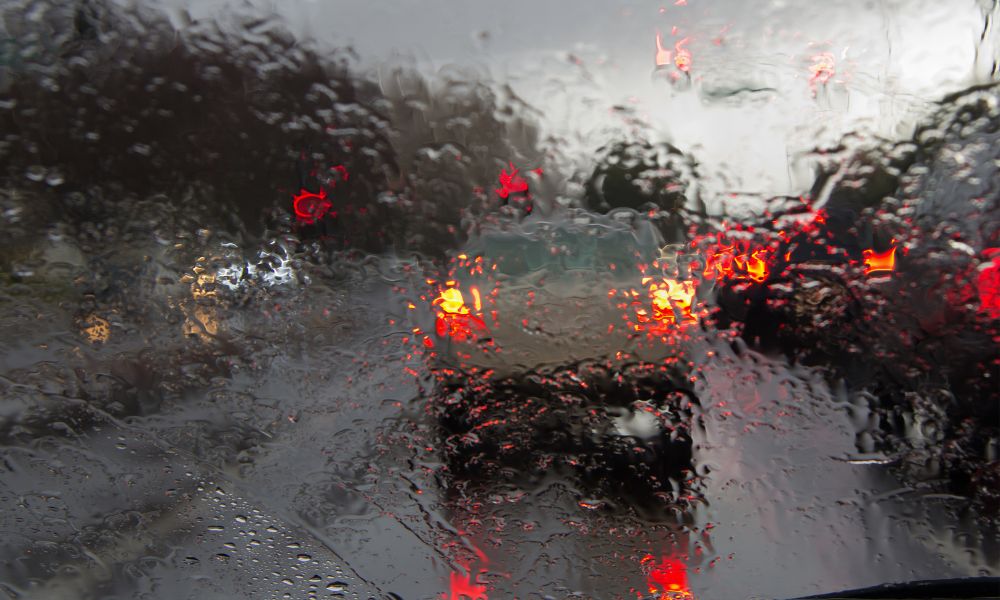There’s no question about it.
Driving in the rain can create complications and increase the risk of accidents.
Unfortunately, there are times when we can’t help it — we HAVE to drive through the heavy downpour.
To help you keep safe during those times, we’ve come up with eight tips for driving in the rain. All these tips will ensure your safety, as well as the safety of others around you.
So shall we begin?
8 Safety Tips for Driving in the Rain

Here are the eight tips that we’ll be talking about:
- Slow down
- Don’t turn on cruise control
- Turn on your lights
- Don’t drive if you don’t have to
- Be familiar with the roads
- Don’t attempt to drive on a flooded road
- Avoid large vehicles
- Know how to handle a skid
Let’s look at these one by one.
Tip 1: Slow Down
The number one rule when driving in the rain is to slow down. This is because slowing down significantly reduces the chances of skidding.
It also gives you enough time and space in case the car in front of you makes a wrong move.
Yes, slowing down even prevents hydroplaning.
What’s tricky with hydroplaning is that you don’t need to have a strong downpour for your tires to experience this – it can happen even when there’s just light rain.
So always remember — slow down, no matter how light the rain is.
Tip 2: Don’t Turn on Cruise Control
Cruise control is very useful when you’re driving on dry roads. However, when activated during wet conditions, it can lead to accidents.
The problem with cruise control is that it automatically accelerates your car and steers your tires in the right direction based on the road it’s on. If it does this while it’s raining, your car might accelerate to an unnecessary speed.
What’s worse is that, with cruise control, you don’t have control of your tires. Without your control, you won’t be able to manage the traction and grip it has on the road (because you just let the car do it).
To add to that, cruise control can encourage distracted driving. And during rainy and snowy weather, you should have your full attention on the road.
Tip 3: Turn On Your Lights
Another important thing you shouldn’t forget is to turn on your lights. This allows you to be visible to other vehicles.
However, only turn on your headlights and taillights, not the brights. Turning on the brights will only throw light to the ground, thus reflecting water. Bright beams make it harder for drivers to see your car.
Now, to know when to turn on your lights, always use your windshield wipers as a reference. If you need to turn on your windshield wipers, you should also turn on your lights.
Tip 4: Don’t Drive If You Don’t Have To
What are the best ways to stay safe when it pours heavily? Don’t drive.
Of course, only if it isn’t necessary.
So if you’re on your way out and there’s a sudden downpour, wait for the rain to stop or lighten. This way, you don’t have to risk getting into an accident.
Remember, it’s better to be safe than sorry.
Tip 5: Be Familiar with the Roads
Say, you’re already out driving. The best thing you can do is stick to the roads you know. Usually, these are highways.
Why? There are a few advantages to doing this.
For one, you’re familiar with whether the road gets flooded or not.
The second is that there will be cars passing that road, too. You can follow the tracks of the previous car and be comfortable that the road ahead is safe to drive in.
Besides, going to unfamiliar places during a heavy pour will only make you more anxious.
Tip 6: Don’t Attempt to Drive on a Flooded Road
There are cases where you CAN drive on flooded roads. That’s if you’re sure that the water is too shallow for your car.
To know if the water is shallow enough, look for signs of the depth of the flood. For example, you can look at a nearby car and see where the water is up. You can also look at a nearby sign or a pole to gauge how deep the water is.
You should always practice this, especially if there are no other roads available.
Tip 7: Avoid Large Vehicles
Even when driving slowly, driving alongside a large vehicle, such as a bus or a truck, can be dangerous.
The spray that comes from the tires of these vehicles can reduce your visibility. What’s worse is that if you’re driving a sedan, they might not even see you beside them.
So take the safer route. Either you let them pass or you stay in front of them while making sure that all your lights are turned on.
Tip 8: Know How to Handle a Skid
What if you just can’t avoid skidding or hydroplaning?
How do you handle that situation?
Well, here’s what to do.
First, don’t suddenly step on the brakes. We know this is counterintuitive, but slamming on the brakes will make it harder for you to control your car.
Instead, you should slowly lift your foot from the gas while slightly steering your car in the direction of the skid.
What’s more, don’t panic. Just keep calm and wait for your car to get back in control.
Conclusion
So those were the 8 tips for driving in the rain.
Remember, if you can help it, avoid driving in heavy downpours at all times.
But if you must drive, then always keep our safety tips in mind. Drive slowly, make sure you have full control, turn on your lights, drive on familiar roads, don’t go into flooded areas, avoid large vehicles, and learn how to handle skidding.
All these will keep you as safe as you can be.
Safe driving!
For other driving tips, you can visit our website here.
